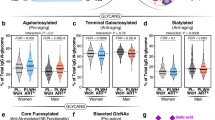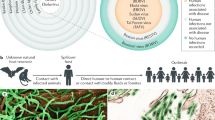Abstract
The Knops blood group antigen erythrocyte polymorphisms have been associated with reduced falciparum malaria-based in vitro rosette formation (putative malaria virulence factor). Having previously identified single-nucleotide polymorphisms (SNPs) in the human complement receptor 1 (CR1/CD35) gene underlying the Knops antithetical antigens Sl1/Sl2 and McCa/McCb, we have now performed genotype comparisons to test associations between these two molecular variants and severe malaria in West African children living in the Gambia. While SNPs associated with Sl:2 and McC(b+) were equally distributed among malaria-infected children with severe malaria and control children not infected with malaria parasites, high allele frequencies for Sl 2 (0.800, 1365/1706) and McCb (0.385, 658/1706) were observed. Further, when compared to the Sl 1/McCa allele observed in all populations, the African Sl 2/McCb allele appears to have evolved as a result of positive selection (modified Nei–Gojobori test Ka−Ks/s.e.=1.77, P-value <0.05). Given the role of CR1 in host defense, our findings suggest that Sl 2 and McCb have arisen to confer a selective advantage against infectious disease that, in view of these case–control study data, was not solely Plasmodium falciparum malaria. Factors underlying the lack of association between Sl 2 and McCb with severe malaria may involve variation in CR1 expression levels.
This is a preview of subscription content, access via your institution
Access options
Subscribe to this journal
Receive 6 digital issues and online access to articles
$119.00 per year
only $19.83 per issue
Buy this article
- Purchase on Springer Link
- Instant access to full article PDF
Prices may be subject to local taxes which are calculated during checkout


Similar content being viewed by others
References
Carlson J et al. Human cerebral malaria: association with erythrocyte rosetting and lack of anti-rosetting antibodies. Lancet 1990; 336: 1457–1460.
Treutiger CJ et al. Rosette formation in Plasmodium falciparum isolates and anti-rosette activity of sera from Gambians with cerebral or uncomplicated malaria. Am J Trop Med Hyg 1992; 46: 503–510.
Newbold C et al. Receptor-specific adhesion and clinical disease in Plasmodium falciparum. Am J Trop Med Hyg 1997; 57: 389–398.
Heddini A et al. Fresh isolates from children with severe Plasmodium falciparum malaria bind to multiple receptors. Infect Immun 2001; 69: 5849–5856.
Rowe A, Obeiro J, Newbold CI, Marsh K . Plasmodium falciparum rosetting is associated with malaria severity in Kenya. Infect Immun 1995; 63: 2323–2326.
Rowe JA, Shafi M, Kai O, Marsh K, Raza A . Nonimmune IgM but not IgG binds to the surface of Plasmodium falciparum infected erythrocytes and correlates with rosetting and severe malaria. Am J Trop Med Hyg (in press).
Ringwald P et al. Parasite virulence factors during falciparum malaria: rosetting, cytoadherence, and modulation of cytoadherence by cytokines. Infect Immun 1993; 61: 5198–5204.
Kun JF et al. Merozoite surface antigen 1 and 2 genotypes and rosetting of Plasmodium falciparum in severe and mild malaria in Lambarene, Gabon. Trans R Soc Trop Med Hyg 1998; 92: 110–114.
al-Yaman F et al. Human cerebral malaria: lack of significant association between erythrocyte rosetting and disease severity. Trans R Soc Trop Med Hyg 1995; 89: 55–58.
Rogerson SJ et al. Cytoadherence characteristics of Plasmodium falciparum-infected erythrocytes from Malawian children with severe and uncomplicated malaria. Am J Trop Med Hyg 1999; 61: 467–472.
Scholander C, Treutiger CJ, Hultenby K, Wahlgren M . Novel fibrillar structure confers adhesive property to malaria-infected erythrocytes. Nat Med 1996; 2: 204–208.
Clough B, Atilola FA, Black J, Pasvol G . Plasmodium falciparum: the importance of IgM in the rosetting of parasite-infected erythrocytes. Exp Parasitol 1998; 89: 129–132.
Treutiger CJ, Carlson J, Scholander C, Wahlgren M . The time course of cytoadhesion, immunoglobulin binding, rosette formation, and serum-induced agglutination of Plasmodium falciparum-infected erythrocytes. Am J Trop Med Hyg 1998; 59: 202–207.
Somner EA, Black J, Pasvol G . Multiple human serum components act as bridging molecules in rosette formation by Plasmodium falciparum-infected erythrocytes. Blood 2000; 95: 674–682.
Baruch DI, Gormely JA, Ma C, Howard RJ, Pasloske BL . Plasmodium falciparum erythrocyte membrane protein 1 is a parasitized erythrocyte receptor for adherence to CD36, thrombospondin, and intercellular adhesion molecule 1. Proc Natl Acad Sci USA 1996; 93: 3497–3502.
Gardner JP, Pinches RA, Roberts DJ, Newbold CI . Variant antigens and endothelial receptor adhesion in Plasmodium falciparum. Proc Natl Acad Sci USA 1996; 93: 3503–3508.
Rowe JA, Moulds JM, Newbold CI, Miller LH . P. falciparum rosetting mediated by a parasite-variant erythrocyte membrane protein and complement-receptor 1. Nature 1997; 388: 292–295.
Treutiger CJ, Heddini A, Fernandez V, Muller WA, Wahlgren M . PECAM-1/CD31, an endothelial receptor for binding Plasmodium falciparum-infected erythrocytes. Nat Med 1997; 3: 1405–1408.
Barragan A, Kremsner PG, Wahlgren M, Carlson J . Blood group A antigen is a coreceptor in Plasmodium falciparum rosetting. Infect Immun 2000; 68: 2971–2975.
Barragan A, Fernandez V, Chen Q, von Euler A, Wahlgren M, Spillmann D . The duffy-binding-like domain 1 of Plasmodium falciparum erythrocyte membrane protein 1 (PfEMP1) is a heparan sulfate ligand that requires 12 mers for binding. Blood 2000; 95: 3594–3599.
Moulds JM et al. Expansion of the Knops blood group system and subdivision of Sl(a). Transfusion 2002; 42: 251–256.
Moulds JM, Zimmerman PA, Doumbo OK et al. Molecular identification of Knops blood group polymorphisms found in long homologous region D of complement receptor 1. Blood 2001; 97: 2879–2885.
Hill AV, Allsopp CE, Kwiatkowski D et al. Common west African HLA antigens are associated with protection from severe malaria. Nature 1991; 352: 595–600.
Moulds MK . Serological investigation and clinical significance of high-titer, low-avidity (HTLA) antibodies. Am J Med Technol 1981; 47: 789–795.
Moulds JM, Kassambara L, Middleton JJ et al. Identification of complement receptor one (CR1) polymorphisms in west Africa. Genes Immun 2000; 1: 325–329.
Molyneux ME, Taylor TE, Wirima JJ, Borgstein A . Clinical features and prognostic indicators in paediatric cerebral malaria: a study of 131 comatose Malawian children. Q J Med 1989; 71: 441–459.
Brewster DR, Kwiatkowski D, White NJ . Neurological sequelae of cerebral malaria in children. Lancet 1990; 336: 1039–1043.
McGuire W, Hill AV, Allsopp CE, Greenwood BM, Kwiatkowski D . Variation in the TNF-alpha promoter region associated with susceptibility to cerebral malaria. Nature 1994; 371: 508–510.
Birmingham DJ, Shen XP, Hourcade D, Nickells MW, Atkinson JP . Primary sequence of an alternatively spliced form of CR1. Candidate for the 75 000 M(r) complement receptor expressed on chimpanzee erythrocytes. J Immunol 1994; 153: 691–700.
Kumar S, Tamura K, Jakobsen IB, Nei M . MEGA2: Molecular Evolutionary Genetics Analysis Software, 2001.
McDonald JH, Kreitman M . Adaptive protein evolution at the Adh locus in Drosophila. Nature 1991; 351: 652–654.
Bellamy R, Kwiatkowski D, Hill AV . Absence of an association between intercellular adhesion molecule 1, complement receptor 1 and interleukin 1 receptor antagonist gene polymorphisms and severe malaria in a West African population. Trans R Soc Trop Med Hyg 1998; 92: 312–316.
Herrera AH, Xiang L, Martin SG, Lewis J, Wilson JG . Analysis of complement receptor type 1 (CR1) expression on erythrocytes and of CR1 allelic markers in Caucasian and African American populations. Clin Immunol Immunopathol 1998; 87: 176–183.
Rowe JA, Raza A, Diallo DA et al. Erythrocyte complement receptor 1 expression levels do not correlate with a HindIII restriction fragment length polymorphism in Africans: implications for studies on malaria susceptibility. Genes Immun 2002; 3: 497–500.
Rowe JA, Rogerson SJ, Raza A et al. Mapping of the region of complement receptor (CR) 1 required for Plasmodium falciparum rosetting and demonstration of the importance of CR1 in rosetting in field isolates. J Immunol 2000; 165: 6341–6346.
Sabeti PC, Reich DE, Higgins JM et al. Detecting recent positive selection in the human genome from haplotype structure. Nature 2002; 419: 832–837.
Krych-Goldberg M, Atkinson JP . Structure–function relationships of complement receptor type 1. Immunol Rev 2001; 180: 112–122.
Zimmerman PA, Buckler-White A, Alkhatib G et al. Inherited resistance to HIV-1 conferred by an inactivating mutation in CC chemokine receptor 5: studies in populations with contrasting clinical phenotypes, defined racial background, and quantified risk. Mol Med 1997; 3: 23–36.
Husain SM, Kalavathi P, Anandaraj MP . Analysis of sickle cell gene using polymerase chain reaction & restriction enzyme Bsu 361. Indian J Med Res 1995; 101: 273–276.
Rozas J, Rozas R . DnaSP version 3: an integrated program for molecular population genetics and molecular evolution analysis. Bioinformatics 1999; 15: 174–175.
Acknowledgements
We thank L Miller, AG Palmer III, M Johnson, and E Eichler for helpful discussions during this study, and B Greenwood, D Kwiatkowski, CEM Allsopp, S Bennett, and N Anstey who contributed to conduct and design of the original case–control study. Funding support was provided by the National Institutes of Health (AI R01 42367 (JMM) and the Wellcome Trust (AVSH is a Wellcome Trust Principal Research Fellow and 055167 (JAR)).
Author information
Authors and Affiliations
Corresponding author
Additional information
Nomenclature for the Knops blood group Swain–Langley has been updated at the International Society of Blood Transfusion Nomenclature Committee meeting, 27th Congress of the ISBT, Vancouver, British Columbia as follows. The Swain–Langley-positive phenotype and antigen previously referred to as Sl(a+) and Sla are now Sl:1 and Sl1, respectively; the allele Sla is now Sl 1. The antithetical phenotype and antigen previously referred to as Vil+ and Vil are now Sl:2 and Sl2, respectively; the allele Vil, is now Sl 2. Nomenclature for the Knops blood group, McCoy phenotype, antigen, and allele are McC(a+), McCa, McCa, and McC(b+), McCb, McCb (Geoff Daniels, personal communication).
Rights and permissions
About this article
Cite this article
Zimmerman, P., Fitness, J., Moulds, J. et al. CR1 Knops blood group alleles are not associated with severe malaria in the Gambia. Genes Immun 4, 368–373 (2003). https://doi.org/10.1038/sj.gene.6363980
Published:
Issue Date:
DOI: https://doi.org/10.1038/sj.gene.6363980
Keywords
This article is cited by
-
No Evidence that Knops Blood Group Polymorphisms Affect Complement Receptor 1 Clustering on Erythrocytes
Scientific Reports (2017)
-
Human genetic polymorphisms in the Knops blood group are not associated with a protective advantage against Plasmodium falciparum malaria in Southern Ghana
Malaria Journal (2013)
-
Complement receptor 1 polymorphisms associated with resistance to severe malaria in Kenya
Malaria Journal (2005)



